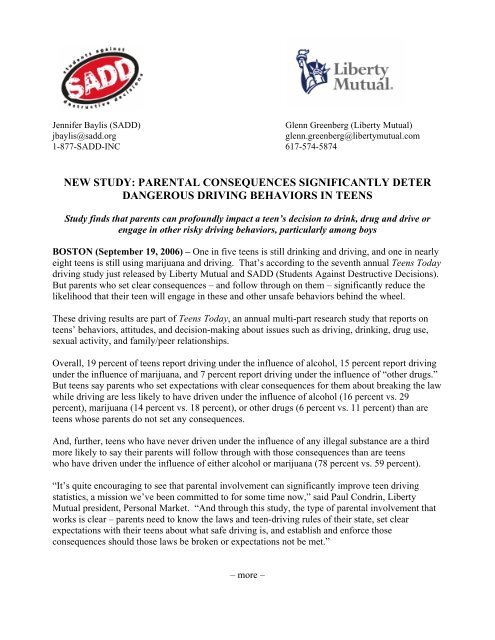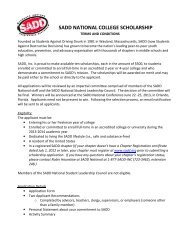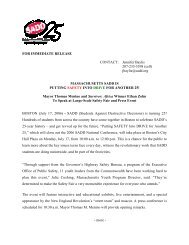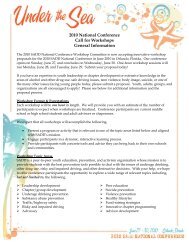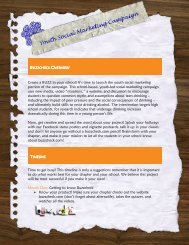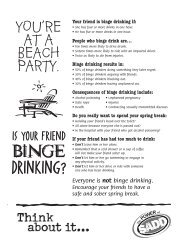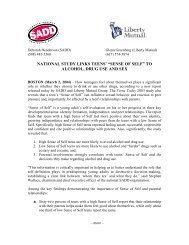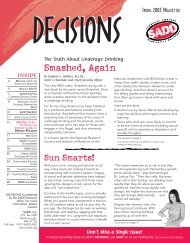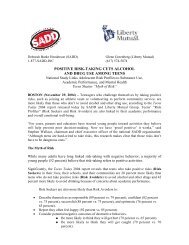parental consequences significantly deter - SADD
parental consequences significantly deter - SADD
parental consequences significantly deter - SADD
Create successful ePaper yourself
Turn your PDF publications into a flip-book with our unique Google optimized e-Paper software.
Jennifer Baylis (<strong>SADD</strong>) Glenn Greenberg (Liberty Mutual)<br />
jbaylis@sadd.org<br />
glenn.greenberg@libertymutual.com<br />
1-877-<strong>SADD</strong>-INC 617-574-5874<br />
NEW STUDY: PARENTAL CONSEQUENCES SIGNIFICANTLY DETER<br />
DANGEROUS DRIVING BEHAVIORS IN TEENS<br />
Study finds that parents can profoundly impact a teen’s decision to drink, drug and drive or<br />
engage in other risky driving behaviors, particularly among boys<br />
BOSTON (September 19, 2006) – One in five teens is still drinking and driving, and one in nearly<br />
eight teens is still using marijuana and driving. That’s according to the seventh annual Teens Today<br />
driving study just released by Liberty Mutual and <strong>SADD</strong> (Students Against Destructive Decisions).<br />
But parents who set clear <strong>consequences</strong> – and follow through on them – <strong>significantly</strong> reduce the<br />
likelihood that their teen will engage in these and other unsafe behaviors behind the wheel.<br />
These driving results are part of Teens Today, an annual multi-part research study that reports on<br />
teens’ behaviors, attitudes, and decision-making about issues such as driving, drinking, drug use,<br />
sexual activity, and family/peer relationships.<br />
Overall, 19 percent of teens report driving under the influence of alcohol, 15 percent report driving<br />
under the influence of marijuana, and 7 percent report driving under the influence of “other drugs.”<br />
But teens say parents who set expectations with clear <strong>consequences</strong> for them about breaking the law<br />
while driving are less likely to have driven under the influence of alcohol (16 percent vs. 29<br />
percent), marijuana (14 percent vs. 18 percent), or other drugs (6 percent vs. 11 percent) than are<br />
teens whose parents do not set any <strong>consequences</strong>.<br />
And, further, teens who have never driven under the influence of any illegal substance are a third<br />
more likely to say their parents will follow through with those <strong>consequences</strong> than are teens<br />
who have driven under the influence of either alcohol or marijuana (78 percent vs. 59 percent).<br />
“It’s quite encouraging to see that <strong>parental</strong> involvement can <strong>significantly</strong> improve teen driving<br />
statistics, a mission we’ve been committed to for some time now,” said Paul Condrin, Liberty<br />
Mutual president, Personal Market. “And through this study, the type of <strong>parental</strong> involvement that<br />
works is clear – parents need to know the laws and teen-driving rules of their state, set clear<br />
expectations with their teens about what safe driving is, and establish and enforce those<br />
<strong>consequences</strong> should those laws be broken or expectations not be met.”<br />
– more –
Teens Today – page 2<br />
The study finds that setting expectations and following through on <strong>consequences</strong> may help prevent<br />
teens from getting into car crashes, which are the leading cause of death for American teens – more<br />
than drugs, guns, or any disease combined. Establishing <strong>consequences</strong> also cuts down on the<br />
number of teens who engage in other unsafe driving behaviors:<br />
• Teens whose parents establish clear <strong>consequences</strong> for breaking family driving rules are less<br />
likely to drive more than 5 mph over the speed limit (44 percent) than are teens whose<br />
parents do not set <strong>consequences</strong> (56 percent).<br />
• Teens whose parents establish clear <strong>consequences</strong> for breaking family driving rules are less<br />
likely to drive with three or more passengers in a car (36 percent vs. 42 percent) or eat or<br />
drink while driving (31 percent vs. 40 percent) than are their counterparts who do not have<br />
any clear <strong>consequences</strong> set.<br />
• Interestingly, simply establishing <strong>consequences</strong> about talking on the cell phone while<br />
driving does not <strong>significantly</strong> influence behavior. However, teens who say their parents are<br />
likely to enforce any established <strong>consequences</strong> for breaking their family driving rule about<br />
cell phones are <strong>significantly</strong> less likely to talk on the cell phone while driving (37 percent)<br />
than are teens who say their parents are unlikely to actually follow through on any<br />
consequence (65 percent).<br />
Parental Power: Study Shows Parents Holding Back on Guidance<br />
In many instances, parents are actually present while teens engage in risky driving habits. Even<br />
when adults are in the car with teens, the Liberty Mutual/<strong>SADD</strong> study shows that teens engage in<br />
bad driving choices, such as speeding (almost 50 percent of the time), talking on their cell phones<br />
(about 20 percent of the time), and eating or drinking while driving (almost 20 percent of the time).<br />
“Parents can play an incredibly influential role in the driving behavior of their teens,” said Stephen<br />
Wallace, chairman and chief executive officer of the national <strong>SADD</strong> organization. “Perhaps most<br />
important is to set a good example for young drivers and to reinforce their good driving habits by<br />
praising what they are doing right behind the wheel.”<br />
Paying Special Attention to Our Teenage Boys<br />
The Liberty Mutual/<strong>SADD</strong> driving study also found that boys are more likely than girls to have<br />
driven under the influence of alcohol, marijuana, and other drugs (32 percent vs. 25 percent), yet<br />
boys say their parents are less likely to speak to them about driving safely. In addition, parents are<br />
establishing the fewest <strong>consequences</strong> for their teenage boys when it comes to this behavior.<br />
“Older teen boys are more likely than girls to engage in bad driving choices while adults are<br />
present,” said Condrin. “While it’s important to talk to both teenage girls and boys about safe<br />
driving, parents should remember that boys are more at risk these days for destructive driving.”<br />
– more –<br />
Teens Today – page 3
What Parents Can Do<br />
"While young people across the country have done a remarkable job of helping to reduce alcoholrelated<br />
crash deaths among their peers by almost 60 percent since 1981, this new data makes clear<br />
that their work is not done," said Wallace. “Too many teens continue to drink and drug and drive,<br />
and parents must be relentless in talking to their teens about this important issue.”<br />
The seventh annual Teens Today driving study builds upon six years of previous research. Experts<br />
on teen driving behaviors, Liberty Mutual and <strong>SADD</strong> offer these additional tips to help parents talk<br />
to their teens.<br />
• Know your state’s Graduated Driver License law, including restrictions on supervised<br />
driving, time of day, and passengers in the car and enforce them.<br />
• Set family rules about driving, outline clear <strong>consequences</strong> for breaking the rules, and<br />
follow through. Liberty Mutual and <strong>SADD</strong> suggest some rules, if they are not covered<br />
by your state laws:<br />
o No friends in the car without an adult;<br />
o No driving after 10 p.m.;<br />
o No use of alcohol or other drugs;<br />
o No distractions while driving including eating, changing CDs, handling iPods<br />
and putting on makeup; and<br />
o No cell phone use, including text messaging.<br />
• Start talking with children as young as 13 or 14 about driving and driving safety. From<br />
focus groups, Liberty Mutual and <strong>SADD</strong> have learned from parents of teen drivers that<br />
the best times to talk with teens about driving safety are during the 1-2 years before they<br />
get their license.<br />
• Continue supervised driving once your child has received his or her license and reinforce<br />
the rules and safe driving habits.<br />
• Don’t relent. Parents should continue the dialogue with their teens and frequently<br />
reinforce the acute dangers of drinking and driving or using drugs and driving.<br />
Liberty Mutual also provides a practical tool for families to safely manage the formative teen<br />
driving process: “The Road Ahead: Stay Safe at the Wheel.” This kit, developed in cooperation<br />
with <strong>SADD</strong> and RADD – “The Entertainment Industry’s Voice for Road Safety” – and free to all<br />
families, includes a powerful video of teens discussing their driving attitudes and behaviors before<br />
and after viewing the HBO Family documentary “Smashed: Toxic Tales of Teens and Alcohol.”<br />
The kit also includes a guide with tips for how to foster a discussion with teens about staying safe at<br />
the wheel and a family safe driving pledge.<br />
– more –<br />
Teens Today – page 4
A free copy of “The Road Ahead” is available by calling 1-800-4-LIBERTY or any local Liberty<br />
Mutual office.<br />
Methodology<br />
Liberty Mutual and <strong>SADD</strong> commissioned Guideline to conduct a quantitative survey with high<br />
school students on a wide range of attitudes and behaviors relevant to teens. An entire section of<br />
the survey was dedicated to teen driving. The driving report focuses exclusively on the responses of<br />
903 teens with a driver’s license from a national sample of 26 high schools in April and May 2006.<br />
The relevant, driving-specific findings can be interpreted at a 95% confidence interval with a +/-<br />
3.3% error margin. Analysis of survey subgroups is subject to wider error margins. Percentages in<br />
the report may add to more or less than 100% due to rounding error or occasions when multiple<br />
response answers were accepted.<br />
Research Partners<br />
Liberty Mutual Group (www.libertymutual.com) is a leading multi-line insurer in the U.S. whose largest line of<br />
business is personal auto based on 2005 direct written premium. A top ten provider of auto and home insurance to<br />
individuals, Liberty Mutual is an industry leader in affinity partnerships, offering its personal lines products to<br />
employees and members of more than 9,000 companies, credit unions, and alumni and professional associations.<br />
Liberty Mutual Group ranks 102 on the Fortune 500 list of largest corporations in the United States. The company,<br />
headquartered in Boston, Massachusetts, employs over 39,000 people in more than 900 offices throughout the world.<br />
<strong>SADD</strong>, Inc. (Students Against Destructive Decisions) is the nation’s premier peer-to-peer youth education organization,<br />
with thousands of chapters in middle schools, high schools, and colleges. With a mission of preventing destructive<br />
behaviors and addressing attitudes that are harmful to young people, <strong>SADD</strong> sponsors programs that address issues such<br />
as underage drinking, substance abuse, impaired driving, and teen violence, depression, and suicide.<br />
###


